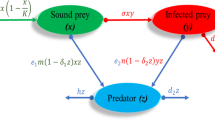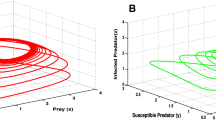Abstract
A predator–prey model with infection in the prey population, including fear, refuge and harvesting factors, is proposed. An expression for basic reproduction number is obtained. Depending on reproduction number, global stability of disease-free and endemic equilibria is established. We have found that disease can be eradicated from the system by controlling the value of basic reproduction number less than one. In addition, deterministic model is analyzed for transcritical and Hopf bifurcations. Thresholds of parameters are identified which determine when the equilibrium is disease-free and when it becomes endemic. An extension is made in the deterministic model by including environmental noise. Sufficient conditions for extinction of species are derived based on environmental noise. We observed that the stochastic system fluctuates around the solutions of corresponding deterministic system when the intensity of white noise is low, whereas high intensity drive the populations to extinction. For justification of analytical results, we have performed numerical simulations and presented the results, which manifest the reliability of the model from ecological viewpoint.












Similar content being viewed by others
Data availability statements
All data generated or analyzed during this study are included in this article.
References
W.O. Kermack, A.G. McKendrick, Contributions to the mathematical theory of epidemics. II. The problem of endemicity. Proc. R. Soc. Lond. Ser. A 138(834), 55–83 (1932)
H.I. Freedman, A model of predator-prey dynamics as modified by the action of a parasite. Math. Biosci. 99(2), 143–155 (1990)
Y. Xiao, L. Chen, Modeling and analysis of a predator–prey model with disease in the prey. Math. Biosci. 171(1), 59–82 (2001)
M. Haque, E. Venturino, The role of transmissible diseases in the Holling–Tanner predator–prey model. Theor. Popul. Biol. 70(3), 273–288 (2006)
K.P. Hadeler, H.I. Freedman, Predator–prey populations with parasitic infection. J. Math. Biol. 27(6), 609–631 (1989)
S. Mondal, A. Lahiri, N. Bairagi, Analysis of a fractional order eco-epidemiological model with prey infection and type 2 functional response. Math. Methods Appl. Sci. 40(18), 6776–6789 (2017)
S. Biswas, P.K. Tiwari, S. Pal, Delay-induced chaos and its possible control in a seasonally forced eco-epidemiological model with fear effect and predator switching. Nonlinear Dyn. 104(3), 2901–2930 (2021)
C. Gokila, M. Sambath, K. Balachandran, Y.K. Ma, Analysis of stochastic predator–prey model with disease in the prey and Holling Type II functional response. Adv. Math. Phys. (2020)
W. Cresswell, Predation in bird populations. J. Ornithol. 152(1), 251–263 (2011)
X. Wang, L. Zanette, X. Zou, Modelling the fear effect in predator–prey interactions. J. Math. Biol. 73(5), 1179–1204 (2016)
G.C. Trussell, P.J. Ewanchuk, C.M. Matassa, The fear of being eaten reduces energy transfer in a simple food chain. Ecology 87(12), 2979–2984 (2006)
S.J. McCauley, L. Rowe, M.J. Fortin, The deadly effects of nonlethal predators. Ecology 92(11), 2043–2048 (2011)
L. Vesel, D.S. Boukal, M. Buric, P. Kozk, A. Kouba, A. Sentis, Effects of prey density, temperature and predator diversity on nonconsumptive predator-driven mortality in a freshwater food web. Sci. Rep. 7(1), 1–9 (2017)
G.F. Gause, The Struggle for Existence: A Classic of Mathematical Biology and Ecology (Courier Dover Publications, New York, 2019)
R.A. Dolbeer, W.R. Clark, Population ecology of snowshoe hares in the central Rocky Mountains. J. Wildl. Manag. 39, 535–549 (1975)
F. Chen, L. Chen, X. Xie, On a Leslie-Gower predator–prey model incorporating a prey refuge. Nonlinear Anal. Real World Appl. 10(5), 2905–2908 (2009)
N. Sk, P.K. Tiwari, S. Pal, M. Martcheva, A delay non-autonomous model for the combined effects of fear, prey refuge and additional food for predator. J. Biol. Dyn. 15(1), 580–622 (2021)
S. Samanta, R. Dhar, I.M. Elmojtaba, J. Chattopadhyay, The role of additional food in a predator–prey model with a prey refuge. J. Biol. Syst. 24(02n03), 345–365 (2016)
N. Sk, P.K. Tiwari, Y. Kang, S. Pal, A nonautonomous model for the interactive effects of fear, refuge and additional food in a prey–predator system. J. Biol. Syst. 29(01), 107–145 (2021)
I. Hanski, L. Hansson, H. Henttonen, Specialist predators, generalist predators, and the microtine rodent cycle. J. Anim. Ecol. 60, 353–367 (1991)
C. Magal, C. Cosner, S. Ruan, J. Casas, Control of invasive hosts by generalist parasitoids. Math. Med. Biol. J. IMA 25(1), 1–20 (2008)
A. Erbach, F. Lutscher, G. Seo, Bistability and limit cycles in generalist predator-prey dynamics. Ecol. Complex. 14, 48–55 (2013)
D. Sen, S. Petrovskii, S. Ghorai, M. Banerjee, Rich bifurcation structure of prey–predator model induced by the Allee effect in the growth of generalist predator. Int. J. Bifurc. Chaos 30(06), 2050084 (2020)
V. Weide Rodrigues, D. Cristina Mistro, L.A. Diaz Rodrigues, Pattern formation and bistability in a generalist predator–prey model. Mathematics 8(1), 20 (2020)
D. Hu, H. Cao, Stability and bifurcation analysis in a predator–prey system with Michaelis–Menten type predator harvesting. Nonlinear Anal. Real World Appl. 33, 58–82 (2017)
C.W. Clark, Bioeconomic Modelling and Fisheries Management (Wiley, New York, 1985)
X.A. Zhang, L. Chen, A.U. Neumann, The stage-structured predator–prey model and optimal harvesting policy. Math. Biosci. 168(2), 201–210 (2000)
Y. Zhang, S. Chen, S. Gao, X. Wei, Stochastic periodic solution for a perturbed non-autonomous predator–prey model with generalized nonlinear harvesting and impulses. Physica A 486, 347–366 (2017)
B. Sahoo, B. Das, S. Samanta, Dynamics of harvested-predator–prey model: role of alternative resources. Model. Earth Syst. Environ. 2(3), 1–12 (2016)
T.C. Gard, Persistence in stochastic food web models. Bull. Math. Biol. 46(3), 357–370 (1984)
R.M. May, Stability and Complexity in Model Ecosystems (Princeton University Press, Princeton, 2019)
S. Zhang, X. Meng, T. Feng, T. Zhang, Dynamics analysis and numerical simulations of a stochastic non-autonomous predator-prey system with impulsive effects. Nonlinear Anal. Hybrid Syst. 26, 19–37 (2017)
A. Das, G.P. Samanta, Stochastic prey–predator model with additional food for predator. Physica A 512, 121–141 (2018)
J. Roy, S. Alam, Fear factor in a prey–predator system in deterministic and stochastic environment. Physica A 541, 123359 (2020)
B. Mondal, U. Ghosh, M.S. Rahman, P. Saha, S. Sarkar, Studies of different types of bifurcations analyses of an imprecise two species food chain model with fear effect and non-linear harvesting. Math. Comput. Simul. 192, 111–135 (2022)
P.S. Mandal, M. Banerjee, Stochastic persistence and stationary distribution in a Holling–Tanner type prey–predator model. Physica A 391(4), 1216–1233 (2012)
O. Ovaskainen, B. Meerson, Stochastic models of population extinction. Trends Ecol. Evol. 25(11), 643–652 (2010)
N.V. Devi, D. Jana, Impact of stochastic perturbation on the persistence and extinction risk of a multi-delayed prey–predator system in non-autonomous environment. Model. Earth Syst. Environ. 7(2), 1241–1267 (2021)
Y. Xia, S. Yuan, Survival analysis of a stochastic predator-prey model with prey refuge and fear effect. J. Biol. Dyn. 14(1), 871–892 (2020)
K.D. Lafferty, A.K. Morris, Altered behavior of parasitized killifish increases susceptibility to predation by bird final hosts. Ecology 77(5), 1390–1397 (1996)
D. Greenhalgh, Q.J. Khan, F.A. Al-Kharousi, Eco-epidemiological model with fatal disease in the prey. Nonlinear Anal. Real World Appl. 53, 103072 (2020)
W.D. Hamilton, R. Axelrod, R. Tanese, Sexual reproduction as an adaptation to resist parasite. Proc. Natl. Acad. Sci. USA 87, 3566–3573 (1990)
D. Mukherjee, Role of fear in predator-prey system with intraspecific competition. Math. Comput. Simul. 177, 263–275 (2020)
J. Wang, Y. Cai, S. Fu, W. Wang, The effect of the fear factor on the dynamics of a predator–prey model incorporating the prey refuge. Chaos 29(8), 083109 (2019)
J. Huang, Y. Gong, S. Ruan, Bifurcation analysis in a predator–prey model with constant-yield predator harvesting. Discrete Contin. Dyn. Syst. B 18(8), 2101 (2013)
V. Lakshmikantham, S. Leela, A.A. Martynyuk, Stability Analysis of Nonlinear Systems (Springer, Switzerland, 1989)
P. Van den Driessche, J. Watmough, Reproduction numbers and sub-threshold endemic equilibria for compartmental models of disease transmission. Math. Biosci. 180(1–2), 29–48 (2002)
Z. Shuai, P. Van den Driessche, Global stability of infectious disease models using Lyapunov functions. SIAM J. Appl. Math. 73(4), 1513–1532 (2013)
L. Perko, Differential Equations and Dynamical Systems, 3rd edn. (Springer, New York, 2001)
E. Allen, Modeling with Itô Stochastic Differential Equations, vol. 22 (Springer, Berlin, 2007)
A.K. Misra, P.K. Tiwari, E. Venturino, Modeling the impact of awareness on the mitigation of algal bloom in a lake. J. Biol. Phys. 42(1), 147–165 (2016)
Acknowledgements
The authors express their gratitude to the reviewers whose comments and suggestions have helped the improvements of this paper.
Funding
The research of Samares Pal is partially supported by Science and Engineering Research Board, Government of India (Grant No. CRG/2019/003248).
Author information
Authors and Affiliations
Ethics declarations
Conflict of interest
The authors declare that there is no conflict of interests regarding the publication of this article.
Ethical standard
The authors state that this research complies with ethical standards. This research does not involve either human participants or animals.
Rights and permissions
About this article
Cite this article
Sk, N., Pal, S. Dynamics of an infected prey–generalist predator system with the effects of fear, refuge and harvesting: deterministic and stochastic approach. Eur. Phys. J. Plus 137, 138 (2022). https://doi.org/10.1140/epjp/s13360-022-02348-9
Received:
Accepted:
Published:
DOI: https://doi.org/10.1140/epjp/s13360-022-02348-9




